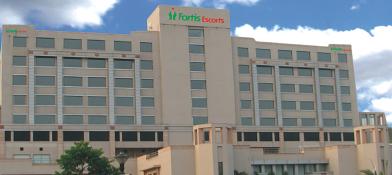Positron Emission Tomography (PET) Scan
Overview
PET scan is an imaging technique that diagnoses various diseases. It reveals the physiologic, metabolic, and biochemical functions of various tissues and organs. It uses a radioactive tracer to display the normal and abnormal metabolic activity of the tissues or organs. It provides the images of the tissues in function. It monitors the disease progression and helps in the treatment plan.
Principle of PET scan
A PET scan detects the functioning of the body's organs and tissues. It measures the functioning by detecting the blood flow, analysing the chemical transmitters in the brain, and the distribution of radioactively labelled drugs.
Detection of the radioactivity emitted by the tissues after injecting the radiotracer dye into the blood vessel is the basic principle on which the PET scan works. oxygen-15, fluorine-18, carbon-11, or nitrogen-13 are the various radioactive tracers that are administered as an intravenous injection. fluorodeoxyglucose (FDG) is the common radioactive tracer that is a radioactive sugar analogue injected for the scan.
The radioactive tracer releases energy in the form of a positron which is taken up by the electron in the organs and the tissues. These electrons in turn emit energy in the form of light which is captured by the PET scanner. PET scanner has some crystals that can take up the light energy. This light energy is converted to electrical signals which are displayed on the computer.
As PET scan mainly targets the molecular activity in the tissues, it helps in the early identification of the disease. As the affected tissue absorbs more radiotracer than the healthy tissues they are called the hot spots.
Indications
PET is used for various conditions.
- It is used to detect cancer, the spread of cancerous tissues, prognosis after cancer treatment, and recurrences.
- Solid tumours of various organs can be detected by using a combination of PET-CT and PET-MRI scans.
- These can also be used to detect heart disorders like reduced blood flow to the cardiac muscles, coronary artery diseases, and heart attack.
- It can also be used to detect tumours of the brain and also degenerative disorders like Alzheimer’s and dementia, and conditions like epilepsy.
- It can also be used to differentiate recurrent cancers from necrosis caused due to radiation and scarring.
- It helps to understand the blood flow and oxygen consumption of various tissues.
- PET scan can also be used to study various chemical mediators of the brain in evaluating psychiatric disorders.
- PET scans can also be used to instruct surgeries on various organs and are called Stereotactic Surgery and Radiosurgery
- These can also be used to identify infection-associated inflammatory conditions like graft infections, osteomyelitis, joint prosthetic infections, and diabetic foot infections.
- This can also be used in autoimmune diseases of thyroid, and rheumatoid arthritis, to understand the disease activity.
- PET scan also has immense use in studying bone metabolism, metastasis, and blood flow.
Contraindications
PET scan is not indicated in pregnant women and breastfeeding women. However, if the benefits outweigh the risks the scan is taken based on the decision taken by the healthcare provider (HCP). Breastfeeding women should continue feeding only after they confirm the elimination of the tracer from the body. This is also not indicated in individuals who cannot remain still for a long duration. This is also not indicated in claustrophobic individuals. This cannot be done when individuals have high blood glucose levels in their bodies. Recent radio or chemotherapies are also contraindicated for PET scans as they can make interpretation difficult.
Types of PET scans
PET scans can be used as a supplementary or combined with other imaging modalities to obtain special views. This is called fusion imaging as images from the two scans can be combined to get a better interpretation. PET-CT scan and PET-MRI are the two types of image fusion.
PET Units
PET scan units contain a huge machine called a gantry with a round, donut-shaped hole in the center. Multiple detectors or scanners are present that take up the photoemission from the individual.
Before PET scan
An individual undergoing a PET scan procedure can have their regular diet and medications. It is advisable to inform the HCP of the medical history, previous surgeries, allergies to radioactive tracers, and medications. One should also inform the HCP of pregnancy and breastfeeding. Metal things like jewellery, watches, hairpins, spectacles, dentures, wigs, hearing aids, wired bras, and cosmetics with metal particles should be removed. Information regarding the presence of any metal prostheses should be given to the healthcare provider.
One should not do strenuous exercise as it can alter the uptake of tracer from the tissues. It is advisable to take a low-carbohydrate, no-sugar diet before the scan. Blood sugar levels in diabetics should be checked before the scan. It is advisable to avoid caffeine, alcohol, or tobacco before the scan. One has to empty the bladder before taking the scan.
During the scan
An individual getting a PET scan is made to lie on the table. In case of anxiety or claustrophobia, anxiety-reducing drugs will be given. The procedure is painless. An intravenous line is accessed and a tracer is injected. One can feel a cold sensation as the tracer travels into the body. It takes about 30-60 minutes for the tracer to be absorbed by the body and reach the target site. Later scan will be taken. If a combination scan like PET-CT is taken, the CT scan is taken first followed by a PET scan.
After the procedure
One can resume activities of daily living after a PET scan. The results will be interpreted by the HCP.
Risks and complications
Except for the allergy to the radioactive tracer, there are not many risks and complications associated with the procedure.
Conclusion
PET scan is an advanced nuclear medicine imaging modality that is used to diagnose various diseases. It enables functional imaging, especially for cancers, and cardiac and brain conditions.



















